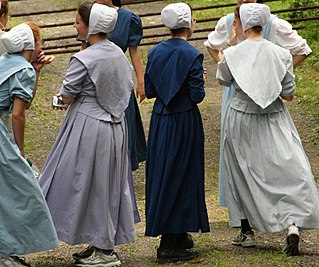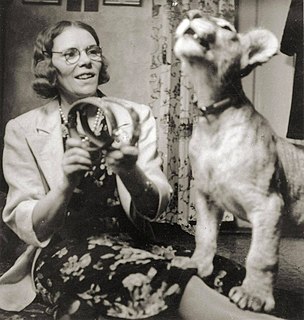Related Research Articles

Kalona is a city in Washington County, Iowa. It is part of the Iowa City metropolitan area. The population was 2,630 at the time of the 2020 census. Kalona is the second-largest city in Washington County.

Plain people are Christian groups characterized by separation from the world and by simple living, including plain dressing in modest clothing. Many Plain people have an Anabaptist background. These denominations are largely of German, Swiss German and Dutch ancestry, though people of diverse backgrounds have been incorporated into them. Conservative Friends are traditional Quakers who are also considered plain people; they come from a variety of different ethnic backgrounds.

The Nebraska Amish, also called Old Schoolers, are a relatively small affiliation of the Amish. They are the most conservative subgroup of Amish, indicated not only by their use of technology but also by their particular style of dress. They emerged in 1881 as a conservative split from the Byler Amish who themselves emerged as the first conservative splinter group from the Amish mainstream in 1849.

The Old Order River Brethren are a River Brethren denomination of Anabaptist Christianity with roots in the Radical Pietist movement. As their name indicates, they are Old Order Anabaptists.
The New Order Amish are a subgroup of Amish that split away from the Old Order Amish in the 1960s for a variety of reasons, which included a desire for "clean" youth courting standards, meaning they do not condone the practice of bundling, or non-sexually lying in bed together, during courtship. Tobacco and alcohol are also not allowed. They also wished to incorporate more evangelical elements into the church, including Sunday school and mission work. Some scholars see the group best characterized as a subgroup of Old Order Amish, despite the name.
Weavertown Amish Mennonite Church is a Beachy Amish Mennonite congregation located in the village of Weavertown, between the somewhat larger villages of Bird-in-Hand and Intercourse in Lancaster County, Pennsylvania, United States.

Amish Mennonites came into existence through reform movements among North American Amish mainly between 1862 and 1878. These Amish moved away from the old Amish traditions and drew near to the Mennonites, becoming Mennonites of Amish origin. Over the decades, most Amish Mennonites groups removed the word "Amish" from the name of their congregations or merged with Mennonite groups.

Pinecraft is a small neighborhood community of Amish and Mennonites and a census-designated place. It is situated near the intersection of Bahia Vista Street and Beneva Road in Sarasota, Florida, U.S. It is a popular winter vacation spot for many North American Amish and Mennonites, particularly from Indiana, Ohio and Pennsylvania.
Julia Mae Spicher Kasdorf is an American poet.

The Beachy Amish Mennonites, also known as the Beachy Mennonites, are an Anabaptist group of churches in the Conservative Mennonite tradition that have Amish roots. Although they have retained the name "Amish" they are quite different from the Old Order Amish: they do not use horse and buggy for transportation, with a few exceptions they do not speak Pennsylvania German anymore, nor do they have restrictions on technology except for radio and television. In the years 1946 to 1977 a majority was transformed into an evangelical revivalist denomination. The traditionalists who wanted to preserve the old Beachy Amish ways then withdrew and formed their own congregations. Today they are known as Midwest Beachy Amish Mennonites or Old Beachy Amish.

Ida Maria Åkerblom was the leader of the Finnish Åkerblom Movement, an evangelical movement sometimes called a "cult". She had also served some time in prison. Her movement deemed her a prophet and began in the 1920s. Maria Åkerblom is characterized by Aarni Voipio as a "sleeping preacher", that is, a person who peaches in a state of trance.

The Amish, formally the Old Order Amish, are a group of traditionalist Anabaptist Christian church fellowships with Swiss German and Alsatian origins. They are closely related to Mennonite churches, another Anabaptist denomination. The Amish are known for simple living, plain dress, Christian pacifism, and slowness to adopt many conveniences of modern technology, with a view neither to interrupt family time, nor replace face-to-face conversations whenever possible, and a view to maintain self-sufficiency. The Amish value rural life, manual labor, humility, and Gelassenheit, all under the auspices of living what they interpret to be God's word.

Helena Konttinen was a Finnish Christian prophet, a "sleeping preacher", whose religious activities were between the years 1893 and 1916, mostly located at Uukuniemi. Konttinen was married and she had four children.
Troyer is a last name which is widespread among the Amish, Brethren and the Mennonites. It is the Pennsylvania German form of the German last name "Dreier", "Dreyer" or "Treyer". Hans Treyer, an early Anabaptist leader, died as a martyr of his faith in Bern in 1529.
Subgroups of Amish developed over the years, as Amish churches have divided many times over doctrinal disputes. The 'Old Order' Amish, a conservative faction that withdrew from fellowship with the wider body of Amish in the 1860s, are those that have most emphasized traditional practices and beliefs. There are many different subgroups of Amish with most belonging, in ascending order of conservatism, to the Beachy Amish, New Order, Old Order, or Swartzentruber Amish groups.
The Noah Hoover Mennonites, called "Old Order Mennonite Church (Hoover)" by the Mennonite World Conference, and sometimes called "Scottsville Mennonites”, are a group of very plain Old Order Mennonites that originally came from the Stauffer Mennonites and later merged with several other groups. Today it is seen as an independent branch of Old Order Mennonites. The group differs from other Old Order Mennonites by having settlements outside the US and Canada and by attracting new members from other groups on a larger scale. They have more restrictions on modern technology than all other Old Order Mennonite groups. They are rather intentionalist minded than ultra traditional.
The Kauffman Amish Mennonites, also called Sleeping Preacher Churches or Tampico Amish Mennonite Churches, are a plain, car-driving branch of the Amish Mennonites whose tradition goes back to John D. Kauffman (1847-1913) who preached while being in a state of trance and who was seen as a "sleeping preacher". In 2017 the Kauffman Amish Mennonites had some 2,000 baptized members and lived mainly in Missouri and Arkansas. In contrast to other Amish Mennonites they have retained their identity over the last hundred years and also largely the Pennsylvania German language and other Amish Mennonite traditions from the late 1800s.
John D. Kauffman was an Amish Mennonite minister and later bishop who preached while being in a state of trance and who was seen as a "sleeping preacher". The Kauffman Amish Mennonites, a group with about 3,500 members, still adhere to his teachings.
Noah Troyer, was an Amish Mennonite farmer who preached while being in a state of trance and who was seen as a "sleeping preacher".
References
- ↑ Don Yoder: Trance-Preaching in the United States, in Pennsylvania Folklife 18 (Winter 1968/69), page 12.
- ↑ Aarni Voipio: Sleeping Preachers: a Study in Ecstatic Religiosity, Helsinki, 1951, Pages 41-42.
- ↑ Don Yoder: Trance-Preaching in the United States in Pennsylvania Folklife 18 (Winter 1968/69), page 15.
- ↑ Harry H. Hiller: The Sleeping Preacher: An Historical Study of the Role of Charisma in Amish Society in Pennsylvania Folklife 18 (Winter 1968/69), page 12.
- ↑ "Bro. Troyer". Herald of Truth . Vol. 19, no. 10. Goshen College Mennonite Historical Library. May 15, 1882. p. 152.
{{cite news}}: CS1 maint: others (link) - ↑ Sleeping Preacher Churches at Global Anabaptist Mennonite Encyclopedia Online.